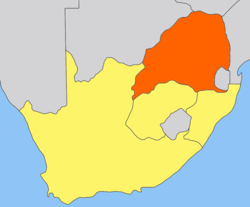| Tenure | Portrait | Incumbent | Notes |
|---|
| Governors |
|---|
| 5 May 1797 to 20 November 1798 |  | George Macartney, 1st Earl Macartney | Known for the 1793 Macartney Embassy to China |
| 20 November 1798 to 9 December 1799 |  | Francis Dundas | 1st time, acting |
| 10 December 1799 to 20 April 1801 |  | Sir George Yonge, 5th Baronet | |
| 21 April 1801 to 20 February 1803 |  | Francis Dundas | 2nd time, acting |
| Commissioner-general |
|---|
| 21 February 1803 to 25 September 1804 |  | Jacob Abraham de Mist | Represented the Batavian Republic |
| Governors |
|---|
| 1 March 1803 to 18 January 1806 |  | Jan Willem Janssens | Represented the Batavian Republic |
| 10 January 1806 to 17 January 1807 |  | Sir David Baird, 1st Baronet | Military governor, acting |
| 17 January 1807 to 21 May 1807 | | Henry George Grey | 1st time, acting |
| 22 May 1807 to 4 July 1811 |  | Du Pré Alexander, 2nd Earl of Caledon | |
| 5 July 1811 to 5 September 1811 | | Henry George Grey | 2nd time, acting |
| 6 September 1811 to 6 April 1814 |  | John Cradock, 1st Baron Howden | |
| 18 October 1813 to 7 January 1814 | | Robert Meade | Acting for Cradock; son of Theodosia, Countess of Clanwilliam |
| 6 April 1814 to 5 March 1826 |  | Lord Charles Somerset | |
| 13 January 1820 to 30 November 1821 |  | Sir Rufane Shaw Donkin | Acting for Somerset |
| 5 March 1826 to 9 September 1828 |  | Richard Bourke | Acting |
| 9 September 1828 to 10 August 1833 |  | Sir Galbraith Lowry Cole | |
| 10 August 1833 to 16 January 1834 | | Thomas Francis Wade | Acting (for D'Urban from 10 January 1834) |
| 10 January 1834 to 20 January 1838 |  | Sir Benjamin D'Urban | |
| 22 January 1838 to 18 March 1844 |  | Sir George Thomas Napier | |
| 18 March 1844 to 27 January 1847 |  | Sir Peregrine Maitland | |
| Governors and high commissioners for Southern Africa |
|---|
| 27 January 1847 to 1 December 1847 |  | Sir Henry Pottinger | |
| 1 December 1847 to 31 March 1852 |  | Sir Harry Smith, 1st Baronet | |
| 31 March 1852 to 26 May 1854 |  | George Cathcart | |
| 26 May 1854 to 5 December 1854 |  | Charles Henry Darling | Acting |
| 5 December 1854 to 15 August 1861 |  | Sir George Grey | |
| 20 August 1859 to 4 July 1860 |  | Robert Wynyard | 1st time, acting for Grey |
| 15 August 1861 to 15 January 1862 | 2nd time, acting |
| 15 January 1862 to 20 May 1870 |  | Sir Philip Wodehouse | |
| 20 May 1870 to 31 December 1870 | | Charles Craufurd Hay | Acting |
| 31 December 1870 to 31 March 1877 |  | Sir Henry Barkly | |
| 31 March 1877 to 15 September 1880 |  | Sir Henry Bartle Frere | Known for initiating the Anglo-Zulu War and the First Boer War |
| 15 September 1880 to 27 September 1880 |  | Henry Hugh Clifford | Acting |
| 27 September 1880 to 22 January 1881 |  | Sir George Strahan | Acting |
| 22 January 1881 to 1 May 1889 |  | Sir Hercules Robinson | 1st time |
| 30 April 1881 to August 1881 | | Sir Leicester Smyth | 1st time, acting for Robinson |
| 25 April 1883 to 26 March 1884 | 2nd time, acting for Robinson |
| 7 April 1886 to 7 July 1886 |  | Sir Henry Torrens | Acting for Robinson |
| 1 May 1889 to 13 December 1889 |  | Henry Augustus Smyth | Acting |
| 13 December 1889 to 30 May 1895 |  | Henry Loch, 1st Baron Loch | |
| 14 January 1891 to 1 December 1892 |  | Sir William Gordon Cameron | 1st time, acting for Loch |
| May 1894 to July 1894 | 2nd time, acting for Loch |
| 30 May 1895 to 21 April 1897 |  | Sir Hercules Robinson | 2nd time; from 10 August 1896, Hercules Robinson, Baron Rosmead |
| 21 April 1897 to 5 May 1897 |  | Sir William Howley Goodenough | Acting |
| 5 May 1897 to 6 March 1901 |  | Alfred Milner, 1st Viscount Milner | |
| 2 November 1898 to 14 February 1899 |  | Sir William Butler | Acting for Milner |
| 6 March 1901 to 31 May 1910 |  | Sir Walter Hely-Hutchinson | |
| 17 June 1909 to 21 September 1909 |  | Sir Henry Scobell | Acting for Hely-Hutchinson |

















































































